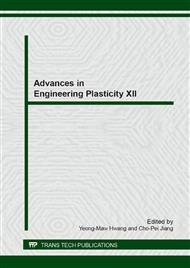[1]
H. Tawfik, Y. Hung, D. Mahajan; Metal bipolar plates for PEM fuel cell-A review. J. Power Sources 163 (2007) 755-767.
DOI: 10.1016/j.jpowsour.2006.09.088
Google Scholar
[2]
S. Gamburzev, A.J. Appleby; Recent progress in performance improvement of PEM fuel cell. J. Power Sources 107 (2002) 5-12.
DOI: 10.1016/s0378-7753(01)00970-3
Google Scholar
[3]
I. Bar-On, R. Kirchain, R. Roth; Technical cost analysis for PEM fuel cells. J. Power Sources 109 (2002) 71-75.
DOI: 10.1016/s0378-7753(02)00062-9
Google Scholar
[4]
A. Hermann, P. Chaudhuri, P. Spagnol; Bipolar plates for PEM fuel cells: a review. Int. J. Hydrogen Energy 30 (2005) 1297-1302.
DOI: 10.1016/j.ijhydene.2005.04.016
Google Scholar
[5]
J.C. Hung, D.H. Chang, Y. Chuang; The fabrication of high-aspect-ratio micro-flow channels on metallic bipolar plates using die-sinking micro-electrical discharge machining. J. Power Sources 198 (2012) 158-163.
DOI: 10.1016/j.jpowsour.2011.09.065
Google Scholar
[6]
S.J. Lee, C.Y. Lee, K.T. Yang, F.H. Kuan, P.H. Lai; Simulation and fabrication of micro-scaled flow channels for metallic bipolar plates by the electrochemical micro-machining process. J. Power Sources 185 (2008) 1115-1121.
DOI: 10.1016/j.jpowsour.2008.07.087
Google Scholar
[7]
H.S. Jang, D.S. Park; Microfabrication of microchannels for fuel cell plates, Sensors 10 (2010) 167-175.
DOI: 10.3390/s100100167
Google Scholar
[8]
T.C. Chen, J.M. Ye; Analysis of stainless steel bipolar plates micro-stamping process. Prz. Elektrotechniczn. 88 (2012) 121-126.
Google Scholar
[9]
S. Mahabunphachai, M. Koç; Fabrication of micro-channel arrays on thin metallic sheet using internal fluid pressure: Investigations on size effects and development of design guidelines. J. Power Sources 175 (2008) 363-371.
DOI: 10.1016/j.jpowsour.2007.09.036
Google Scholar
[10]
J.C. Hung, C.C. Lin; Fabricaton of micro-flow channels metallic bipolar plates by a high-pressure hydroforming apparatus. J. Power Sources 206 (2012) 179-184.
DOI: 10.1016/j.jpowsour.2012.01.112
Google Scholar
[11]
S.S. Lim, YT Kim CG Kang; Fabrication of aluminum 1050 micro-channel proton exchange membrane fuel cell bipolar plate using rubber-pad-forming process. Int J adv Manuf Technl 65(2013) 231-238.
DOI: 10.1007/s00170-012-4162-8
Google Scholar
[12]
L.F. Peng, D.A. Liu, P. Hu, X.M. Lai, J. Ni; Fabrication of metallic bipolar plates for proton exchange membrane fuel cell by flexible forming process-numerical simulations and experiments. J. Fuel Cell Sci. Tech. 7 (2010) 0310091-0310099.
DOI: 10.1115/1.3207870
Google Scholar
[13]
Y.X. Liu, L. Hua; Fabrication of metallic bipolar plate for proton exchange membrane fuel cells by rubber pad forming. J. Power Sources 195(2010) 3529-3535.
DOI: 10.1016/j.jpowsour.2009.12.046
Google Scholar
[14]
S. Maharudrayya, S. Jayanti, A.P. Deshpande; Pressure drop and flow distribution in multiple parallel-channel configurations used in proton-exchange membrane fuel cell stacks. J. Power Sources 157 (2006) 358-367.
DOI: 10.1016/j.jpowsour.2005.07.064
Google Scholar
[15]
R. Boddu, U.K. Marupakula, B. Summers, P. Majumdar; Development of bipolar plates with different flow channel configurations for fuel cells. J. Power Sources 189 (2009) 1083-1092.
DOI: 10.1016/j.jpowsour.2008.12.156
Google Scholar
[16]
X. Li, I. Sabir; Review of bipolar plates in PEM fuel cells: Flow-field designs. Int. J. Hydrogen Energy 30 (2005) 359-371.
DOI: 10.1016/j.ijhydene.2004.09.019
Google Scholar
[17]
L.F. Peng, X.M. Lai, D.A. Liu, P. Hu, J. Ni; Flow channel shape optimum design for hydroformed metal bipolar plate in PEM fuel cell. J. Power Sources 178 (2008) 223-230.
DOI: 10.1016/j.jpowsour.2007.12.037
Google Scholar
[18]
A. Kumar, R.G. Reddy; Effect of channel dimensions and shape in the flow-field distributor on the performance of polymer electrolyte membrane fuel cells. J. Power Sources 113 (2003) 11-18.
DOI: 10.1016/s0378-7753(02)00475-5
Google Scholar
[19]
M.H. Dirikolu, E. Akdemir; Computer aided modeling of flexible forming process. J. Mater. Process. Technol. 148 (2004) 376-381.
DOI: 10.1016/j.jmatprotec.2004.02.049
Google Scholar


